Mirja Busch
A Highway Performance, (detail), 2014, framed C-Print, twopart, 60 x 80 cm each
Mirja Busch’s artistic work is a constant research of new forms of existence and experience of objects. She works with minimalist interventions, irritating common forms of vision and producing shifts in structures of attention, thus allowing for alternative object-space experiences. Traveling is an important aspect of her artistic practice, as creating temporary interventions in remote places allows her to critically question where art can exist, and for whom. In her work, the artist makes use of various mediums as a means to pose new sculptural questions.
Mirja lives and works in Berlin, Germany. She studied visual arts at the HBK Braunschweig and attended the Master en Artes Visuales at the Universidad de Chile. She has spent time working in London (2010) and in Cambridge, MA (2013), where she did archival research at the CAVS Special Collection at M.I.T. She’s been awarded with working grants from Stiftung Kunstfonds (2015), Hans und Charlotte Krull Stiftung (2014) and DAAD (2008). Since 2003 she has been working in parallel in the artist group Pathetic Sympathy Seekers.
Inside, (detail), 2014, four parts, Print on fabric, 238 cm diameter
The installation Inside shows the landscape views from inside Nancy Holt‘s Sun Tunnels. The circular objects have the same diameter as her Sun Tunnels and are installed after original compass degrees. Cutting out the actual work by Nancy Holt, this work points to the simultaneous absence (of the work itself) and presence (through documents) of Land Art works. It also questions the borders of land artworks. Where does it begin and where does it have its limits?
Both works, A Highway Performance and Inside, belong to a series 27 desert days that engage with contemporary experiences of landscape. The series 27 desert days is the result of a research hosted at the CAVS Special Collection (Massachusetts Institute of Technology, Cambridge, MA) and an art travel project through the North American Southwest in early 2013.
Farbfelder (Schwarze Pyramide), 2012, Aryilic on fabric, ceramics, 205 x 160 x 90 cm
Colorfield (Black Pyramid) explores symmetries and interactions between colour field painting and minimal sculpture. The apparently flat canvas is actually twisted, entering and appropriating part of the exhibition space. The black tiles on the floor reinforce that movement towards the exhibition space by displaying an abstract shadow.
M2 (Schwarzes Loch), 2011, Acrylic on fibreboard, 160 x 320 x 1,6 cm
M2 (Black Hole) is about the visual effect that occurs when the eye aims at completing the broken circular movements. The intentionally uneven ordering of the elements produces an effect of depth and three-dimensionality that reminds of a galactic constellation and contrasts with the concreteness and flatness of the object under display.
Untiteld (About Space), 2010, Acrylic on PVC, Cardboard, mirrored PVC, string, 180 x 160 x 170 cm
A front view reveals a massive object made of what appear to be tiles. It hangs, however, from a rather fragile string on a nail and is slightly separated from the wall. A side view reveals its extreme thinness. The mirrored surface underneath reflects the surrounding space conveying a sense of insubstantiality. The work plays thus with weight and lightness, volume and flatness, objectness and spatiality, painting and sculpture.
Untitled (Wolke), 2011, fabric, 100 x 110 x 85 cm
In Untitled (Cloud) hundreds of white buntings condense to a volume and merge with the white corner of the gallery space.
Platform, 2007, wood, 320 x 660 x 1350 cm
This platform was built for a group exhibition. Visitors had access only to the platform and engaged with the exhibited artworks from a heightened position close to the ceiling. Like outdoor observation platforms, this exhibition architecture set a specific spatial choreography for the visitor and prescribed a staged view.
Gelbes Rechteck in drei Dimensionen, 2012, framed C-Print, 42 x 60 cm
Yellow rectangle in three-dimensions is part of the series Red square, yellow rectangle, black rectangle and blue triangle in three-dimensions. In this and other works I subtly refer to pictorial works and elements (here Malevich) and physically translate them into objects. I like to understand this work as a double displacement: from the purest form of abstraction in painting (Suprematism) to natural abstraction in three-dimensional space, and from the White Cube to naturally abstract landscapes.
Stellar (Puddle), 2011, Raisin on C-Print, 0,2 x 120 x 43 cm
Puddle shapes and their reflections are taken from different urban environments and displayed in exhibition spaces. Prints are treated with resin to become flat objects. The puddles refer the viewer to a space outside the exhibition space and interpellate his or her body, as they propose a certain visual perspective from where to look at.
Courtesy of the Artist
Mirja Busch
www.mirjabusch.com
What to read next







